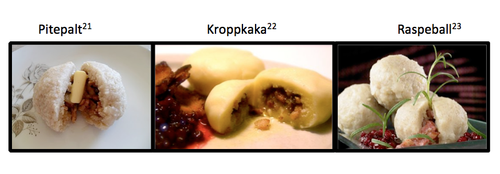After the introduction of the potato to northern Europe, potato dumplings quickly became ubiquitous fare in Scandinavia4. Although these potato dumplings now exhibit regional diversity, three distinct variations of the dumpling have emerged: the “raspeball” in Norway, the “pitepalt” and “kroppkaka” in northern and southern Sweden, respectively. Despite some subtle differences, these three varieties of Scandinavian potato dumplings share a number of important similarities. Interestingly, there are a wide variety of names for the pitepalt, kroppkaka (or kroppkakor), and rasepball, many of which bear logical etymologies that provide insights regarding each dumpling’s genealogy. The Pitepalt gets part of its name, “Pite” from its city of origin, which is Piteå, Sweden4. “Palt” translates literally to “gap,” which undoubtedly refers to the gap or space for the filling inside the dumpling. In addition, “kropp,” the first component of “kroppkaka,” is Swedish for “solid frame”, which may refer to the external dumpling body that encapsulates the filling; “kaka” translates to “cake”, a suffix found on the names of many Swedish other foods19. Finally, “raspe” is the verb “to grate” in Norwegian, which likely refers to the grated potatoes in the dough of the rasepball.

